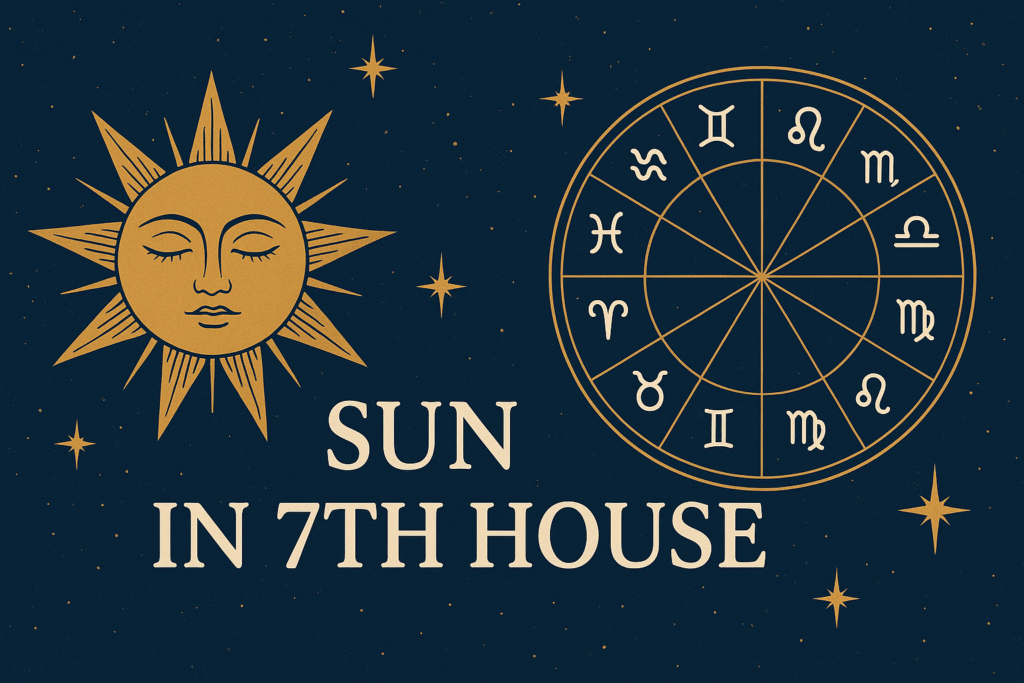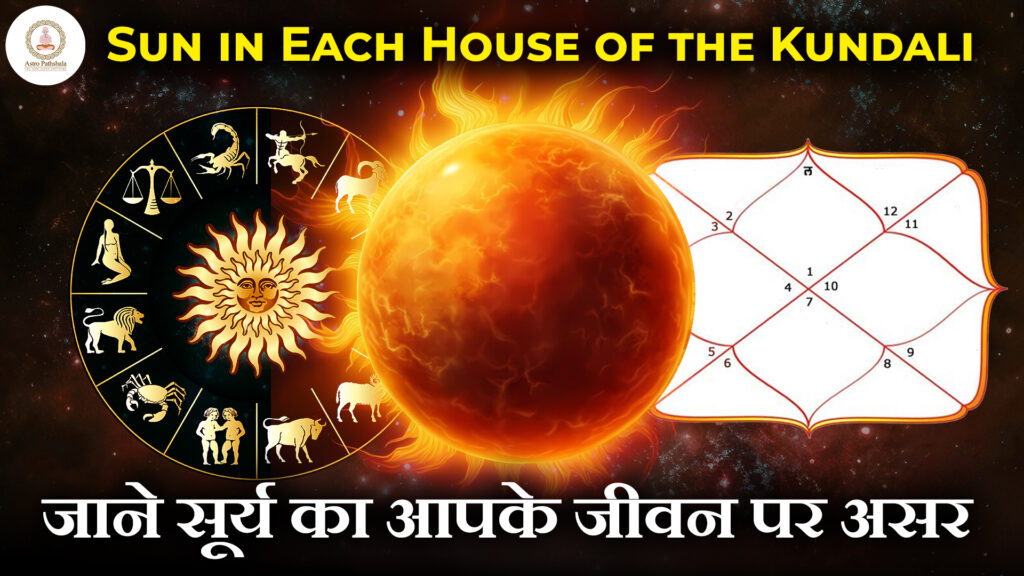The ancient verses of Lal Kitab read like poetry whispered by the stars. Among its secrets, the Sun’s placement in the seventh house stands out. This house, governing marriage, partnerships, contracts, and self-reflection through others, becomes a stage for the radiant Sun. It can burn, illuminate, and sometimes overexpose. Understanding this requires entering the symbolic mansion of Lal Kitab, where each house is a courtyard and each planet a lamp. When the Sun, the eternal giver of life, is in the house of relationships, it acts like a great lamp at the entrance. Its light dazzles outsiders, but often leaves the inside in shadow.

The Nature of the Sun
The Sun, or Surya, is the royal king in the cosmic court. He is the flame of the soul (Ātman), the principle of authority, fatherhood, and dharma. Wherever he sits in a chart, he demands recognition. Like fire, he warms and gives life, but can also scorch and blind. In Lal Kitab’s vision, the Sun is not just a planet; it is a lamp burning in the house where it resides. If well-placed, this lamp radiates auspicious light. If afflicted, it can cause the smoke of ego and pride to fill the house.
When the Sun is in the seventh house, the focus shifts to how partnership is shaped by self-centeredness. The Sun’s strong presence can create admiration and authority in relationships. However, it may also bring challenges in sharing space and mutual understanding. This placement calls for conscious balance between individual pride and partnership harmony.
Positive Effects
A strong Sun in the seventh house often leads to influential partnerships. The native may marry someone of high status and gain recognition through relationships. This placement can bring leadership qualities and a commanding presence, making the individual effective in negotiations and public affairs. Harmonious partnerships here can provide both personal and social advancement.
Imagine a house with a bright front lamp guiding travelers to its door. Similarly, a seventh-house Sun makes relationships the arena for the soul’s purpose, where the spouse mirrors the divine spark within.
A Sanskrit verse from the Rig Veda reminds us of this light:
“Ādityo jyotir-uttamam, jyotir-ādityam uttamam.”
“The Sun is the supreme light, the supreme light is the Sun.”
For the native, the partner may become that supreme light, or the native may serve as the Sun, illuminating their beloved’s path.
When the Sun occupies the seventh house, it tends to weaken Venus, but cannot be weakened by Venus itself. The Sun retains its inherent strength, diminishing the power of Venus in this context.
If the Sun line in the palm emerges from the life line at the point where Jupiter’s line of fortune begins, the results are highly auspicious. However, if a branch from the Sun line extends towards the root of the thumb, happiness from women decreases. Signs of multiple relationships appear, although the person remains fortunate. A woman under this influence guards her honour like the Lajwanti plant, valuing dignity above life itself.
The seventh house belongs to Libra, the balance of Venus and Mercury. With the Sun here, Mercury grows silent and Venus is weakened. Saturn, exalted and an enemy of the Sun, further reduces marital happiness until age 25.
When the Sun shares Mercury’s turret, Mercury lends strength to the Sun but stays subdued until age 17, granting wealth but lesser wisdom. If the Sun’s influence stretches toward Sagittarius, trust issues and trivial thoughts may arise. Wealth from women may come, but refined intelligence is lacking. If the Sun’s branch joins Mercury without touching Sagittarius, the spouse may belong to a wealthy family. But if it bends towards Sagittarius, the children may suffer.
When the Sun enters Libra, the seventh house, in the month of Kartik, it is technically in debilitation. However, Lal Kitab states that the Sun never truly loses its strength. Instead, its intense presence weakens Venus, the house lord.
Negative Effects
Yet, every flame casts shadows. If the Sun is afflicted in this house, its light turns harsh. The native may struggle in marriage, often feeling superior or overshadowing the partner. Ego clashes become frequent, as if both spouses try to claim the same throne. The house that is meant for equality becomes dominated by one blazing lamp, leaving little room for balance.
In Lal Kitab’s imagery, it is as though the Sun has been placed in the western wall of the house. The heat of the afternoon sun burns too fiercely, causing discomfort within. The person may appear radiant in society, admired for their stature, but at home, relationships can feel strained.
Another challenge is that the Sun here may bring instability in partnerships. Marriages may suffer from a lack of harmony, or the native may face separation if humility is not cultivated. The father’s shadow also looms large in this placement. Either the father has a profound influence on the marriage, or there may be karmic debts connected to his presence.
Lal Kitab Symbolism
Lal Kitab teaches us not through dry logic but through vivid, almost folktale-like imagery. The seventh house is described as the courtyard of marriage, where two souls sit together, sharing food and warmth by the fire. When the Sun enters here, it is like lighting a royal torch in the courtyard.
If the lamp burns with clean oil, it emits warmth, radiates majesty, and bestows auspicious blessings. But if the oil is impure, the lamp smokes, blackening the walls and suffocating those who sit within. Thus, the Sun in the seventh house becomes a lesson: pride must give way to partnership. Authority must yield to affection, and the light must illuminate both, not just one.
In Lal Kitab’s treasury of metaphors, the Sun here is like a guest who takes the best seat at the wedding feast, demanding attention. If honoured respectfully, this guest brings blessings to the house with abundance. If neglected or offended, the fire of discord may consume the marital harmony.
Remedies
The beauty of Lal Kitab lies in its simple yet profound remedies, designed not merely to “fix” but to harmonise planetary energies. For the Sun in the seventh house, the remedies centre around humility, respect for partnerships, and acts of light.
The native is advised to serve the father or father-like figures with devotion, for the Sun carries paternal energy. Offering water to the rising Sun each morning strengthens its benevolence. Red cloth or copper articles should be gifted to elders or to the spouse’s family. These actions soothe the Sun’s fiery pride.
One of Lal Kitab’s most evocative remedies is to keep the courtyard of the house clean and to light a lamp in the evening at the threshold. This symbolic act reminds the Sun that its role is to guide both the household and the community, not to scorch them. By sharing light, the Sun finds peace.
Conclusion
The Sun in the seventh house, as seen through Lal Kitab, is both opportunity and challenge. It can grant radiant partnerships or bring shadows of pride and discord. Ultimately, outcomes depend on how we use this inner light: as a source of warmth in partnership, or as an uncontrolled flame.
If we learn to place the Sun’s fire carefully, to let its light shine equally upon ourselves and our partners, then marriage becomes a sacred courtyard, warmed by divine flame. Otherwise, the same flame can consume the bonds of love.
As the old teachers of Lal Kitab would say: The Sun is never to be extinguished; it is only to be placed rightly. In the seventh house, that right placement is not on the throne. It is in the shared lamp of partnership, where two souls, like two hands cupping the same flame, protect and nurture its eternal glow.


